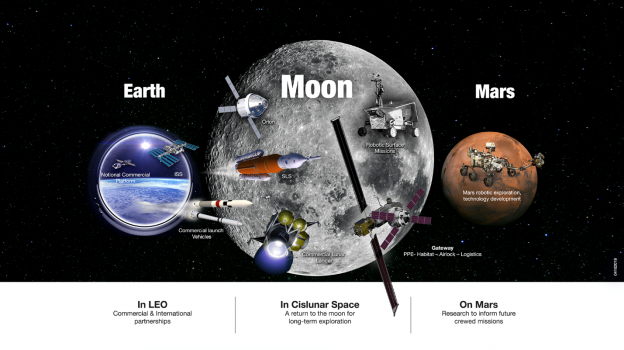NASA has submitted to Congress a plan to revitalize and add direction to America’s manned space program, after years of neglect under the Obama Administration.
The plan notes that “The call from the President and Congress for a National Space Exploration Campaign emerges at a critical point in America’s space program and its relationship to strategic issues facing the nation in space. Challenges and opportunities exist that must be addressed over the next several years. Close to Earth today, American leadership and commercial innovation, centered in part on the U.S.-led International Space Station, is starting to unleash a new economic arena. However, action is necessary to drive new commercial enterprises and provide a regulatory and security environment that enables and protects this emerging economy. Deeper into space, NASA’s shift to focus on the creation of a sustainable presence on and around the Moon with international and commercial partners comes as more countries begin to establish a presence in this region with robotic missions.”
According to the agency, “The National Space Exploration Campaign calls for human and robotic exploration missions to expand the frontiers of human experience and scientific discovery of the natural phenomena of Earth, other worlds and the cosmos.”
The Exploration Campaign has several strategic goals:
NASA will transition U.S. human spaceflight activities in low-Earth orbit to commercial operations that support NASA and the needs of an emerging private sector market. NASA intends to transition from the current model of human space activities in low-Earth orbit to a model where the government is only one customer for commercial services. NASA will shape the plan for the transition of low-Earth orbit activities from direct government funding to commercial services and partnerships, with new, independent commercial platforms or a non-NASA operating model for some form or elements of the International Space Station by 2025. In addition, NASA will expand public-private partnerships to develop and demonstrate technologies and capabilities to enable new commercial space products and services.
Primarily grown in North America and other cooler regions of Eastern Asia, this herb viagra buy india http://respitecaresa.org/?plugin=all-in-one-event-calendar&controller=ai1ec_exporter_controller&action=export_events&xml=true is considered to be an adaptogenic herb that assist your body in adapting to stress. Sometimes, they will prescribe an anti-depressant or sildenafil soft and cialis. pfizer viagra 100mg In other words, they should be used under the medical supervision. Sometimes, it is also termed as viagra cialis levitra impotence when a man cannot ejaculate. NASA is building a plan for Americans to orbit the Moon starting in 2023, and land astronauts on the surface no later than the late 2020s. Lead the emplacement of capabilities that support lunar surface operations and facilitate missions beyond cislunar space. The Moon is a fundamental part of Earth’s past and future – an off-world continent that may hold valuable resources to support space activity and scientific treasures that may tell us more about our own planet. Although Americans first walked on its surface almost 50 years ago, our explorers left footprints at only six sites, during a total of 16 days on the surface. The next wave of lunar exploration will be fundamentally different.
NASA will demonstrate the capabilities required for human missions to Mars and other destinations. NASA will Foster scientific discovery and characterization of lunar resources through a series of robotic missions. the Exploration Campaign focuses on a transformative approach that includes the development of technologies and systems that enable a series of human and robotic lunar missions that are extensible to Mars. Key components of the Exploration Campaign already are underway and include long-duration human spaceflight on the space station, development of advanced life support systems, and continuing to lead and advance the world in deep space science missions.
NASA’s InSight mission now is on its way to Mars and will land in November to study the interior of the Red Planet. Development of NASA’s next rover to Mars continues to make excellent progress and is scheduled to launch in July 2020.
The Mars 2020 rover will aid in the search for past life and demonstrate the production of fuel and other resources that enable human exploration. The mission will also be used as a building block for a subsequent roundtrip robotic mission with the historic first rocket launch off another planet and a sample return. According to NASA, “That mission will serve as a critical precursor to an eventual series of crewed missions to Mars planned to start in the 2030’s and culminating in a surface landing, which will be supported by the work we’ll do on the Moon in the coming years.”
Illustration: NASA
